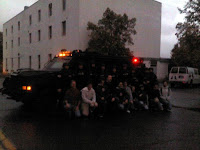Sometimes the members of Spokane Kendo Club enjoy things other than hitting each other in the head with large bamboo swords. We get together for barbecues and outings and parties and all kinds of other things that are not Kendo-related. Including, yesterday, an awesome opportunity to "play" with the Spokane SWAT team!
About a dozen members of our club, including myself, volunteered to be "suspects" so that the new SWAT members could have some real training. They split us up into two groups and used two different buildings, one of them being our new dojo. Our group had seven people in it and they hid us in various places throughout different areas of the building and then let the SWAT team come and clear the areas and find all of us. It was great fun, and when they found us they would detain us (usually with actual handcuffs), possibly interrogate us a bit for information and then escort us out of the building. We did a few different rounds with them, each time hiding in different areas of the building. I have to say they were very thorough (they found all of us every time), and we all had a lot of fun. I'm hoping that we'll be able to join in on any other training activities they might have in the future. For now, enjoy the pictures! (Sorry for the quality, we only had a camera phone at the time):


About a dozen members of our club, including myself, volunteered to be "suspects" so that the new SWAT members could have some real training. They split us up into two groups and used two different buildings, one of them being our new dojo. Our group had seven people in it and they hid us in various places throughout different areas of the building and then let the SWAT team come and clear the areas and find all of us. It was great fun, and when they found us they would detain us (usually with actual handcuffs), possibly interrogate us a bit for information and then escort us out of the building. We did a few different rounds with them, each time hiding in different areas of the building. I have to say they were very thorough (they found all of us every time), and we all had a lot of fun. I'm hoping that we'll be able to join in on any other training activities they might have in the future. For now, enjoy the pictures! (Sorry for the quality, we only had a camera phone at the time):




Comments
Post a Comment